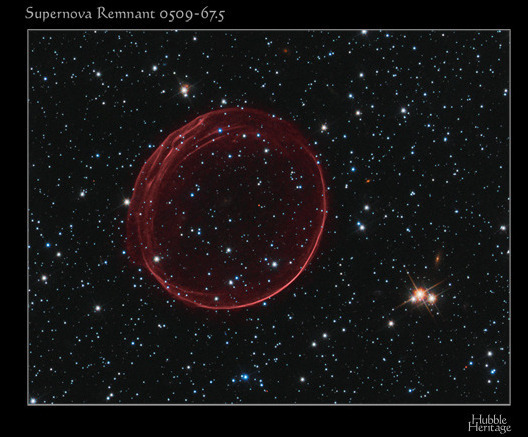
Type Ia supernovae are some of the brightest explosions in the Universe, and some of the most important, since they help us measure the Universe's expansion. Nevertheless, determining exactly what is going on to produce this type of supernova has been a challenge: though white dwarfs are almost certainly involved, astronomers have yet to identify the exact process that causes one to explode. Recent analysis of Hubble Space Telescope data, performed by Bradley E. Schaefer and Ashley Pagnotta of Louisiana State University, argues strongly that at least some type Ia supernovae are the result of a merger between two white dwarfs.
A white dwarf is the dense core that remains after a relatively low-mass star like our Sun has burned through its lighter elements. The heat of fusion is no longer able to counteract a gravity-driven collapse; instead, it's balanced by quantum degeneracy pressure from the Pauli exclusion principle. If it collapsed any further, electrons would be forced into the same quantum state, which isn't possible. (This is similar to the force that keeps neutron stars from collapsing.)
There is a limit to how massive a white dwarf can be: the Chandrasekhar limit, which is about 1.4 times the mass of the Sun. If a white dwarf's mass reaches that limit, it is no longer stable. According to a widely accepted model, it then explodes as a type Ia supernova. Because white dwarfs all have similar characteristics and the same mass when they explode, their explosions should be similar. As a result, they are considered "standard candles," objects with a known intrinsic brightness. That brightness provides an independent measure of their distance, and acts as the foundation for much of modern observational cosmology, including the research behind the 2011 Nobel Prize in physics.
Despite their fundamental importance to cosmology and astrophysics, how type Ia supernovae are produced is still unclear. Several significant models have been proposed, two of which are important for the current work. The double-degenerate model predicts two white dwarfs (degenerate objects) in a close binary; over time, their mutual orbit would decay through gravitational radiation until they collided.
In the single-degenerate model, a white dwarf is in a binary system with an ordinary star. The white dwarf strips gas from its companion's envelope until it has gathered enough to reach the Chandrasekhar limit, after which it explodes.
Stars are difficult to destroy; even an explosion as energetic as a type Ia supernova won't completely annihilate a companion star in a single-degenerate explosion, according to astronomers' best understanding. As Carles Badenes, a supernova researcher at the University of Pittsburgh explains, "We know the white dwarf is obliterated, but the companion star must survive, so it will still be present in the supernova remnant." But a double-degenerate type Ia supernova, since it involves an actual collision, would destroy both white dwarfs, leaving nothing but gas behind in the region where the binary once existed.
Schaefer and Pagnotta carefully analyzed the type Ia supernova remnant SNR 0509-67.5 in the Large Magellanic Cloud. It's the leftovers of an explosion that would have first been visible from Earth about 400 years ago. Any companion star that survived the blast must lie within a certain radius of the supernova's heart, or it wouldn't have been close enough to have gas pulled off by the white dwarf's gravity. The researchers carefully analyzed that region for sufficiently bright stars and star cores.
They found no candidates for a companion star brighter than an absolute magnitude of +8.4 (apparent magnitude +26.9 at that distance)—if there is a companion object, it is very faint. The nearby stars that are bright enough are too far outside the center of the supernova remnant to have fed gas into the white dwarf, the researchers concluded with a confidence of 99.7 percent. Badenes points out if this was a single-degenerate system, "That places very strong limits on the mass range of the star in the original binary system," itself an interesting result.
If the companion star is completely absent, a result consistent with the data, then maybe the double-degenerate model explains the origin of SNR 0509-67.5. In fact, no companion star has ever been identified in a type Ia supernova remnant, with the possible exception of Tycho's supernova—one's been claimed there, but its identity is disputed by many researchers. Proof of a negative is difficult, however: at best, the single case of SNR 0509-67.5 shows that the single-degenerate model doesn't apply to that event. Schaefer and Pagnotta argue that only a double-degenerate binary could be responsible for the supernova.
"Whether or not you agree with the strong conclusions [of the authors]," says Badenes, "this result is very interesting." Perhaps other type Ia supernovae are single-degenerate, but the missing massive companion star predicted by the single-degenerate model in SNR 0509-67.5 is at least consistent with a double-degenerate system. Follow-up observations of this and other type Ia supernova remnants will bring astronomers closer to an understanding of what actually causes these important explosions.
Nature, 2012. DOI: 10.1038/nature10692 (About DOIs).
Listing image by Photograph by heritage.stsci.edu
reader comments
18